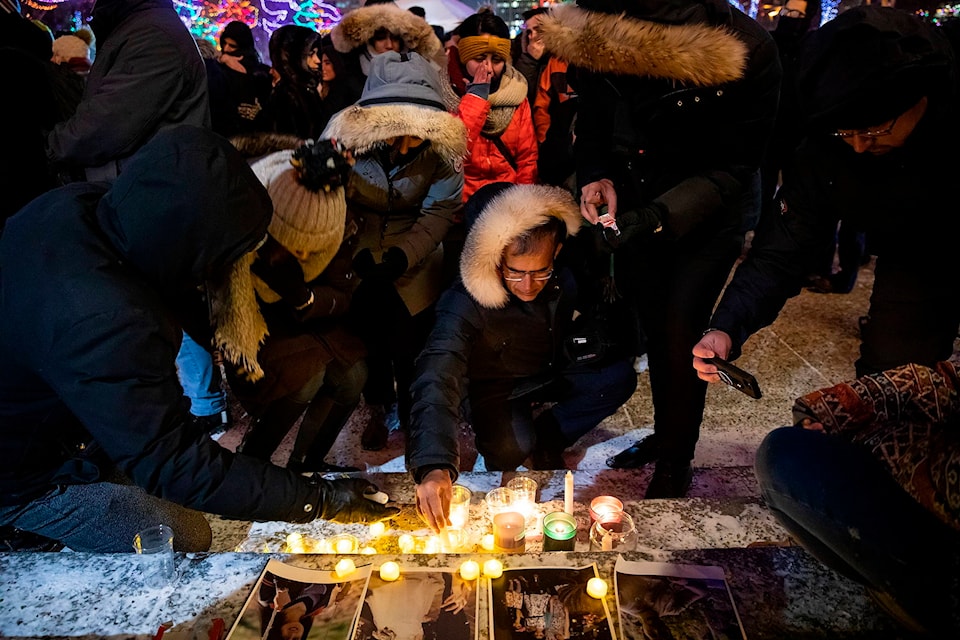OTTAWA — Eight more Canadian officials will travel Monday to Iran to help investigate the downing of a Ukrainian jetliner and assistfamilies of the 57 Canadians who perished in the crash.
Three members of Canada’s standing rapid deployment team arrived Saturday in Iran, establishing a base of operations for the Canadian government in the wake of Wednesday’s plane crash, which killed all 176 people on board.
Foreign Affairs Minister Francois-Philippe Champagne said Sunday that Iran has approved visas for six more members of the team, who are currently in Ankara, Turkey.
Visas have also been issued for two experts from the Transportation Safety Board, Champagne said in a series of tweets.
The eight are to travel to Iran on Monday, Champagne added.
One more member of the rapid deployment team is expected to arrive in Ankara on Monday and Champagne said the government expects Iran to issue a visa for that person “swiftly.”
A spokesman for Champagne said the officials ”will be there to provide consular assistance to the families of the victims, including supporting repatriation of remains, to help identify victims and to assist in the investigation.”
The government’s efforts to get officials on the ground in Tehran have been complicated by the fact that Canada severed all ties with Iran in 2012, shuttering its embassy and recalling all diplomats.
Most of the passengers on the downed plane were Iranians or Iranian-Canadians; 138 of them were en route to Canada. In addition to the 57 Canadian citizens on the plane, The Canadian Press has independently confirmed at least 74 victims with ties to Canada, many of them students and professors returning after spending the December break visiting relatives in Iran.
After initially insisting Iran’s military had no role in the crash, Iranian President Hassan Rouhani admitted in a tweet posted early Saturday in Tehran that the plane was mistaken for a hostile target and accidentally shot down minutes after taking off from Tehran’s airport.
Prime Minister Justin Trudeau, who spoke to Rouhani on Saturday, said he demanded that Canada be fully involved in the investigation, including gaining access to the airplane’s black boxes, and being allowed to participate in DNA identification of the victims. He also demanded consular access for Canadian officials to work with grieving families of Canadian victims in Iran.
Trudeau is scheduled to speak today at a memorial service in Edmonton, home to many of the victims.
Another vigil to honour the victims was held Sunday at the University of Toronto, which lost six students in the tragedy. Deputy Prime Minister Chrystia Freeland said the loss goes well beyond the university.
“This is Toronto’s loss, this is Ontario’s loss and this is Canada’s loss,” an emotional Freeland told the vigil. “Nothing will ever replace these brilliant lives that have been cut short. We will always … bear these scars.”
Ontario Premier Doug Ford also spoke to the mourners, telling them that his government stands “shoulder to shoulder” with the Trudeau government in its determination to bring those responsible for the tragedy to justice.
Trudeau told a news conference Saturday he was “outraged and furious” that so many Canadians are grieving because of Iran’s actions, and that Iran must take “full responsibility” for the “horrific” incident.
“This is a tragedy that should not have happened,” he said, calling for an immediate effort to de-escalate the regional tensions that contributed to the “great loss of innocent life.”
The downing of the jetliner came just hours after Iran had launched missile attacks on military bases in Iraq where U.S. forces are stationed, in retaliation for a U.S. drone strike on Jan. 3 that killed Gen. Qassem Soleimani, Iran’s top general.
Rouhani’s admission that “missiles fired due to human error caused the horrific crash” sparked two days of protests in Iran.
In Tehran, Iran’s security forces deployed in large numbers on Sunday as demonstrators defied the heavy police presence to protest their country’s days of denials that it shot down the Ukrainian plane. Videos posted online showed protesters shouting anti-government slogans and moving through subway stations and sidewalks, many around Azadi, or Freedom, Square after an earlier call for people to demonstrate there. Other videos suggested similar protests were taking place in other Iranian cities.
In Washington, the Trump administration tried to amplify the dissension in Iran. Defence Secretary Mark Esper and President Donald Trump’s national security adviser, Robert O’Brien, appeared on Sunday news shows to suggest the street protests demonstrate the Iranian people’s demand for a regime change.
Trump himself tweeted his support for the protesters.
“To the leaders of Iran - DO NOT KILL YOUR PROTESTERS,” Trump wrote on Twitter. ”Thousands have already been killed or imprisoned by you, and the World is watching. More importantly, the USA is watching. Turn your internet back on and let reporters roam free! Stop the killing of your great Iranian people!”
